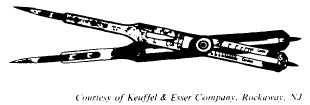45.132X
Figure 2-22.-Proportional dividers.
bar called a beam. The slide-mounted attachments
can be locked in any desired position on the beam.
Thus, a beam compass can be used to draw circles
of any radius up to the length of the beam. With
one or more beam extensions, the length of the
radius of a beam compass ranges from about 18
in. to 70 in.
PROPORTIONAL DIVIDERS
PROPORTIONAL DIVIDERS (fig. 2-22) are
used for transferring measurements from one
scale to another. This capability is necessary when
drawings are to be made to a larger or smaller
scale. They can also be used to divide lines or
circles into equal parts.
Proportional dividers consist of two legs of
equal length, pointed at each end, and held
together by a movable pivot. By varying the
position of the pivot, you can adjust the lengths
of the legs on opposite sides of the pivot so that
the ratio between them is equal to the ratio
between two scales. Therefore, a distance spanned
by the points of one set of legs has the same
relation to the distance spanned by the points of
the other set as one scale has to the other.
On the proportional dividers, a thumb nut
moves the pivot in a rack-and-gear arrangement.
When the desired setting is reached, a thumb-nut
clamp on the opposite side of the instrument locks
the pivot in place. A scale and vernier are
provided on one leg to facilitate accurate setting.
On less expensive models, the movable pivot is
not on a rack and gear, and there is no vernier.
The dividers may be set by reference to the table
of settings that is furnished with each pair; they
will accommodate varying ranges of scales from
1:1 to 1:10. However, it is better not to depend
entirely on the table of settings. You can check
the adjustment by drawing lines representing the
desired proportionate lengths, and then applying
the points of the instrument to them in turn
until, by trial and error, the correct adjustment
is reached.
To divide a line into equal parts, set the divider
to a ratio of 1 to the number of parts desired on
the scale marked Lines. For instance, to divide
a line into three parts, set the scale at 3. Measure
off the length with points of the longer end. The
span of the points at the opposite ends will be
equal to one-third the measured length. To use
proportional dividers to transfer measurements
from feet to meters, draw a line 1 unit long and
another line 3.28 units long and set the dividers
by trial and error accordingly.
Some proportional dividers have an extra scale
for use in getting circular proportions. The scale
marked Circle indicates the setting for dividing
the circumference into equal parts.
The points of the dividers are of hardened
steel, and if they are handled carefully, these
points will retain their sharpness during long
use. If they are damaged, they may be sharpened
and the table of settings will still be usable, but
the scale on the instrument will no longer be
accurate.
SCALES
In one sense, the term scale means the
succession of graduations on any graduated
standard of linear measurement, such as the
graduations on a steel tape or a thermometer. In
another sense, when we refer to the “scale of a
drawing,” the term means the ratio between the
dimensions of the graphic representation of an
object and the corresponding dimensions of the
object itself.
Suppose, for example, that the top of a
rectangular box measures 6 in. by 12 in. If you
draw a 6-in. by 12-in. rectangle on the paper, the
dimensions of the drawing would be the same as
those of the object. The drawing would, therefore,
be a full-scale drawing. This scale could be
expressed fractionally as 1/1, or it could be given
as 1 in. = 1 in.
Suppose that instead of making a full-scale
drawing, you decided to make a half-scale
drawing. You should then draw a 3-in. by 6-in.
rectangle on the paper. This scale could be
2-16

